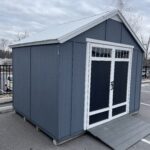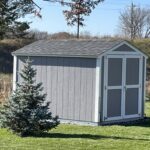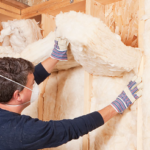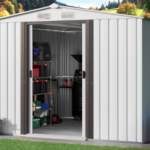Which is Better: Pole Barn, or Stick Built?
Barns, sheds, and out-buildings are important structures. They house everything from yard and garden equipment to farming equipment, animals, feed, hay, and many other things. In some case, they provide for a deluxe she-shed or mancave There are different barn styles and different methods of constructing these buildings. When you start to consider the barn or shed possibilities you will need to compare the styles, and their advantages and disadvantages before you choose the one that is perfect for your budget, space, and needs.
The pole barn and the stick barn are two styles often compared to each other, and countless people have tried to evaluated which is better for them. If you ask barn and shed owners for advice they are going to tell you about their favorite style and leave out the information about the other style. This article will take an in-depth look at these buildings so you can make an informed choice based on facts.
Pole Barn
The term pole barn refers to a structure that is built around poles are posts anchored deep into the ground. These barns are generally constructed out of pre-cut materials.

The upright posts or poles may be laminated wood, creosote-coated poles, or even metal. The material used to create these upright columns is buried in the ground for 4 to 6 feet.
Pole barns are relatively simple structures when it comes down to it, and because of that they can often be built quickly and for a reasonable cost.
Pole barns have high ceilings and they do not have floors or basements. The structures can be made with any exterior covering you choose, but they rarely have interior finishes. They can accommodate heavy equipment, large animals, and many bales of hay.
Pole Barn Advantages
- Concrete slabs are not required. I’ve seen pole barns built over dirt and gravel and stand that way for decades. Not using concrete can save significant cost these days.
- Less site prep. Site prep can be costly and time consuming. With a pole barn, it doesn’t matter if the site is not perfectly level or not completely prepped — as long as the poles go in as they should.
- Easy modifications. It is easy to add to the barn at a later date, because the core structure is pretty basic and open.
- Less expensive. They are cheaper to construct because they use fewer materials.

Pole barns afford much larger doors - Fast construction. Pole barns can go up really fast. They are pretty simple, with a predictable frame and metal roof and siding. Less labor means more money savings.
- Strong and dependable. Pole barns stand for a long time with relatively little maintenance, as long as the poles themselves don’t rot (they should not).
- Very open design. They do not have load-bearing interior walls, making them great when the goal is to store large items or things like grain or seed.
- Low maintenance. There isn’t much to do with a pole barn other than be sure the siding and roofing stays in place after big storms.
- Ability to have very wide doors. The framing poles are farther apart so wider entry doors can be installed.
- Flexible design. The sides can be left open, or they can be enclosed, depending on how you are using the structure.
Pole Barn Disadvantages
- They have less insulation. In places that have below-freezing temperatures often the pole barn is not a great option if you intend to heat it. There just isn’t as much of an opportunity to insulate it well, given the open wall design. Luckily, though, pole buildings doesn’t really require much winterizing.
- You might not have many creature comforts. The customization and design features are limited because of the method of construction and materials used. If you are looking for lots of rooms, lofts, windows, etc., a pole barn might not be best.
- Harder to seal off. In many pole barns, the floors might be dirt and the wall edges might not seal to the ground, so they may not drain well, and rodents and snakes and other animals can easily get inside.
- Not every city likes them. Pole barns may not meet the local zoning restrictions, and many HOA shed rules will prohibit them. Why? Then tend to be taller than normal, built of metal, and often have a more industrial look than a stick-built garage or shed.
Stick Built Buildings
The term stick building refers to a structure that is built on-site using individual boards and materials. A normal detached garage, for example, would be considered stick

built. A stick barn can be called a custom build because the carpenters have the opportunity to cut each piece of material to fit perfectly and to make changes in the design if changes are called for.
Stick Built Advantages
- Can seal completely, to the ground. Stick built buildings seal tighter and keeps unwanted animal guests out.
- Easier to insulate and control inside temperature. These buildings are better in areas that see extremely cold winters with snow, because you can insulate them well and even partition areas off easily.
- Design and customization is unlimited. You pretty much get to build whatever you want, in whatever shape you want. You can do any siding or roof option, too.
- Has a foundation and concrete floor. A stick built building has a foundation, and almost always has concrete, although some might choose to use a wooden floor. Generally, you have a better floor in stick-built.
- Much better if you want living space, like a mancave, she-shed, or sleeping quarters. Easily converts into a liveable structure.
- More zoning friendly. They can be altered to meet zoning laws in your area.
- Better curb appeal. Exterior finishes are unlimited.
- More configurable inside. Interior walls and ceilings are easier to install because the building is framed to accommodate them.
Stick Built Disadvantages
- Cost more to build. More materials and labor are required to construct the building, and they almost always require more site prep.

Stick-built usually requires concrete - Concrete and footers are likely required. Most stick buildings will need a concrete or peer and beam foundation.
- Not as open. Doors and entryways are smaller so they cannot handle larger equipment. Wall heights in most stick-built structures is a standard 8 foot.
- Slower to build. The materials are not pre-cut so each piece has to be measured, cut, and then installed.
Pole Barn vs. Stick Built: The Verdict
Pole barns are cheaper to build, and you can store larger, heavier equipment in them. Stick-built barns are easier to insulate, heat, and cool, and they stop unwanted critters from building their homes in your barn.
Whether a pole barn or a stick built building is better depends completely on the site where you are building it, the way you plan to use the shed or barn, and the amount of money you want to spend.
Use a Pole Barn If:
If you strictly want a barn for equipment storage, feed storage, and animal storage the pole barn is your best option. If you need to store large items in the building, such as

tractors or large machinery, a pole barn is going to be way more open. If you are on a tight budget or need the building up fast, a pole barn is better. Finally, if you are trying to built on a less-than-perfect site, like one with a slight scope, go with a pole shed.
Use a Stick-Built Building If:
If you want a building that can be finished with a nice interior, including various rooms and lofts, a stick-built building might be better. For those who need a building that can be temperature-controlled with things like plumbing, then a custom-designed then a stick built barn is your best option. If the building might be intended to have living or sleeping quarters at any point, stick-built is by far better. And if you want a design that is something other than a rectangle or square, you will prefer a stick-built building.











